
Contents ◼ Introduction ◼ Part One Mechanisms in marine pollution ◼ Part two Topics in marine pollution ◼ Part three Measurement of biological response toxicity and water quality assessments ◼
Contents ◼ Introduction ◼ Part One Mechanisms in marine pollution ◼ Part two Topics in marine pollution ◼ Part three Measurement of biological response toxicity and water quality assessments ◼
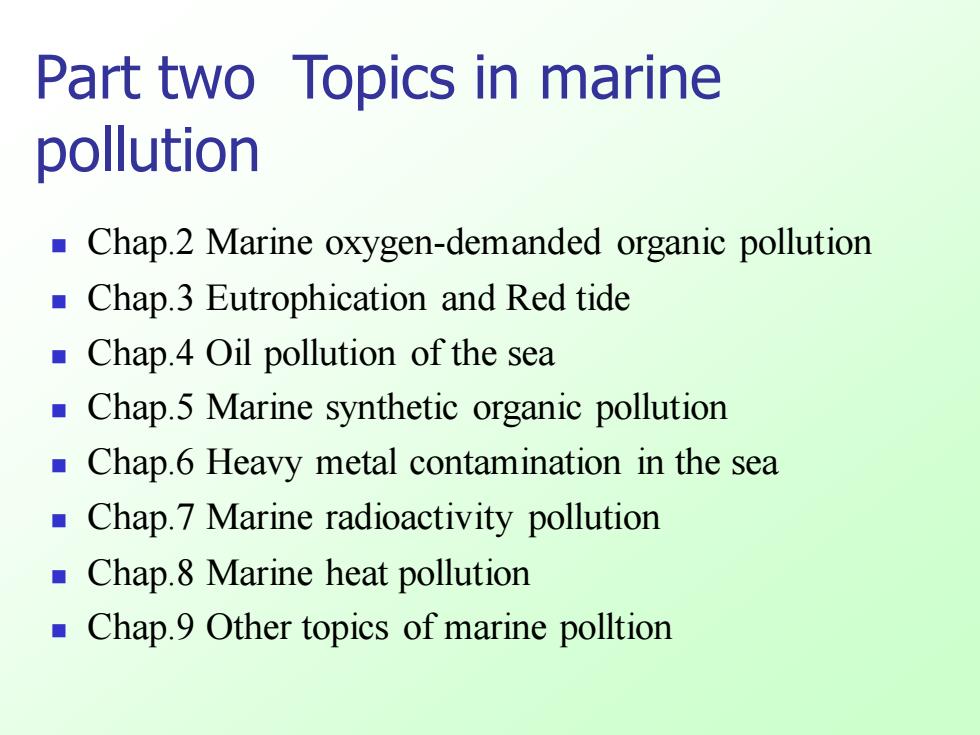
Part two Topics in marine pollution ◼ Chap.2 Marine oxygen-demanded organic pollution ◼ Chap.3 Eutrophication and Red tide ◼ Chap.4 Oil pollution of the sea ◼ Chap.5 Marine synthetic organic pollution ◼ Chap.6 Heavy metal contamination in the sea ◼ Chap.7 Marine radioactivity pollution ◼ Chap.8 Marine heat pollution ◼ Chap.9 Other topics of marine polltion
Part two Topics in marine pollution ◼ Chap.2 Marine oxygen-demanded organic pollution ◼ Chap.3 Eutrophication and Red tide ◼ Chap.4 Oil pollution of the sea ◼ Chap.5 Marine synthetic organic pollution ◼ Chap.6 Heavy metal contamination in the sea ◼ Chap.7 Marine radioactivity pollution ◼ Chap.8 Marine heat pollution ◼ Chap.9 Other topics of marine polltion
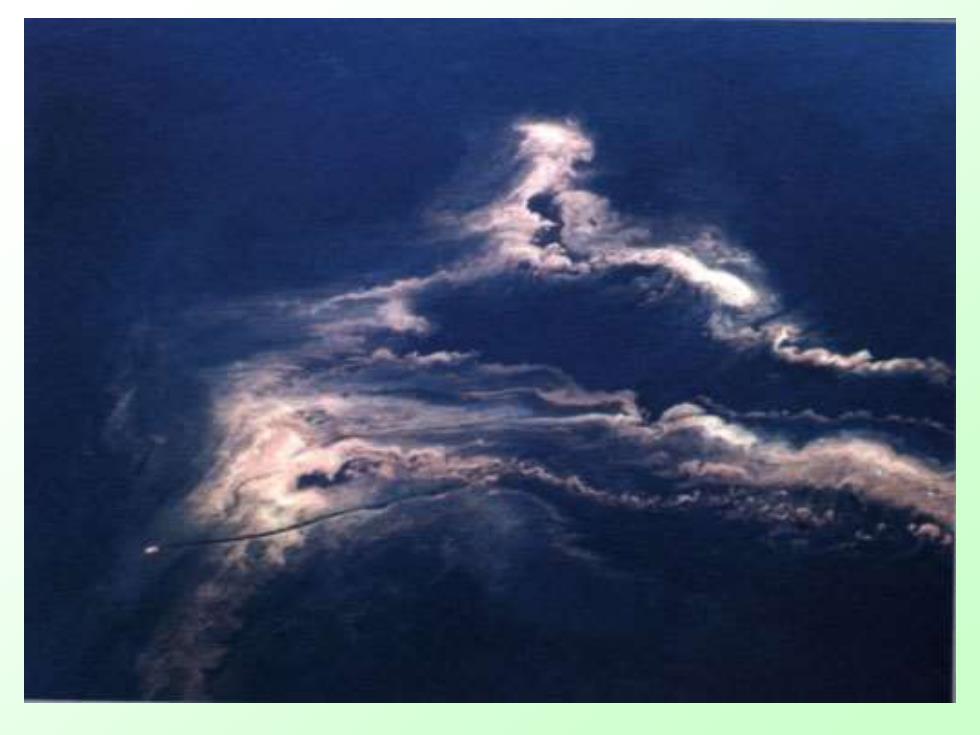
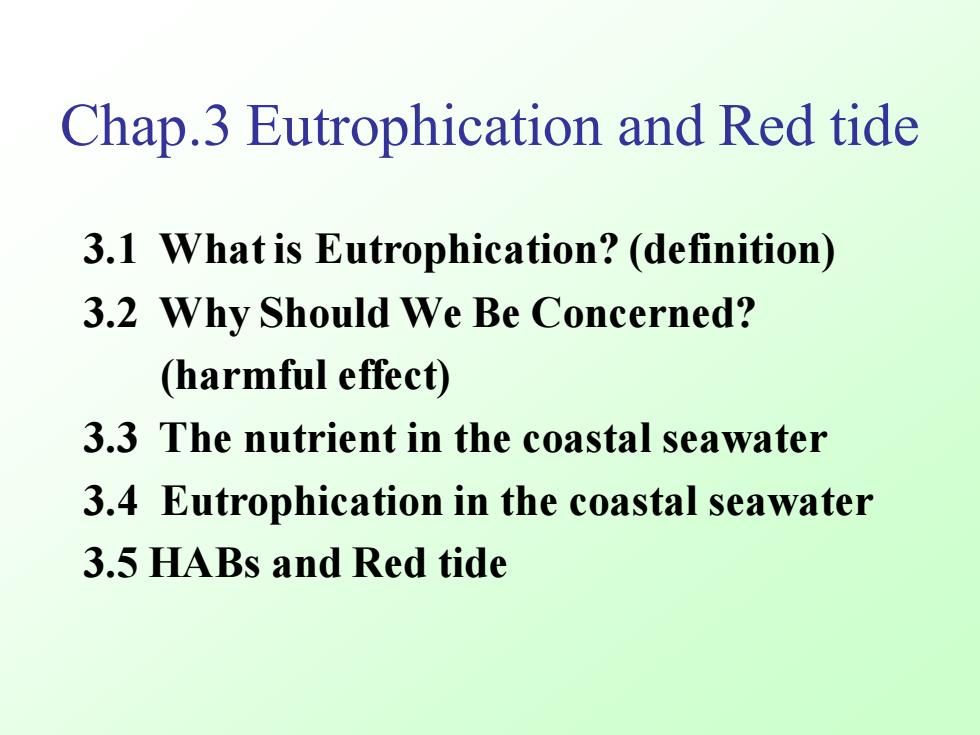
Chap.3 Eutrophication and Red tide 3.1 What is Eutrophication? (definition) 3.2 Why Should We Be Concerned? (harmful effect) 3.3 The nutrient in the coastal seawater 3.4 Eutrophication in the coastal seawater 3.5 HABs and Red tide
Chap.3 Eutrophication and Red tide 3.1 What is Eutrophication? (definition) 3.2 Why Should We Be Concerned? (harmful effect) 3.3 The nutrient in the coastal seawater 3.4 Eutrophication in the coastal seawater 3.5 HABs and Red tide
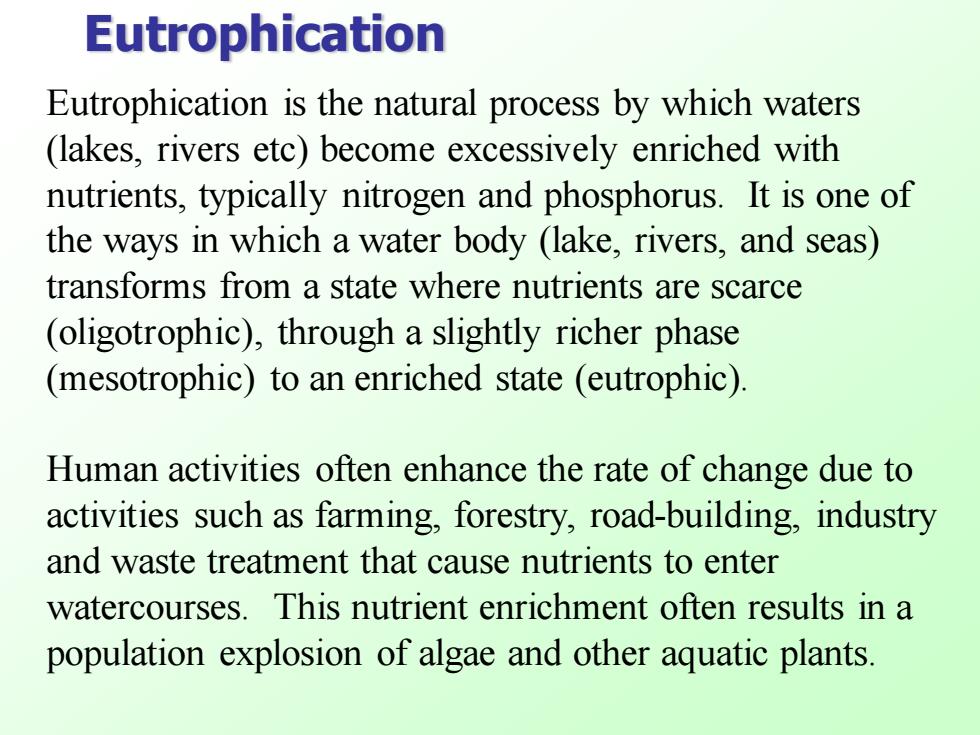
Eutrophication Eutrophication is the natural process by which waters (lakes, rivers etc) become excessively enriched with nutrients, typically nitrogen and phosphorus. It is one of the ways in which a water body (lake, rivers, and seas) transforms from a state where nutrients are scarce (oligotrophic), through a slightly richer phase (mesotrophic) to an enriched state (eutrophic). Human activities often enhance the rate of change due to activities such as farming, forestry, road-building, industry and waste treatment that cause nutrients to enter watercourses. This nutrient enrichment often results in a population explosion of algae and other aquatic plants
Eutrophication Eutrophication is the natural process by which waters (lakes, rivers etc) become excessively enriched with nutrients, typically nitrogen and phosphorus. It is one of the ways in which a water body (lake, rivers, and seas) transforms from a state where nutrients are scarce (oligotrophic), through a slightly richer phase (mesotrophic) to an enriched state (eutrophic). Human activities often enhance the rate of change due to activities such as farming, forestry, road-building, industry and waste treatment that cause nutrients to enter watercourses. This nutrient enrichment often results in a population explosion of algae and other aquatic plants

Eutrophication BOD and Eutrophication - rapid succession in a body of water because of an increase in biological productivity. (Oligotrophic lakes and rivers have clear water and low biological productivity)
Eutrophication BOD and Eutrophication - rapid succession in a body of water because of an increase in biological productivity. (Oligotrophic lakes and rivers have clear water and low biological productivity)
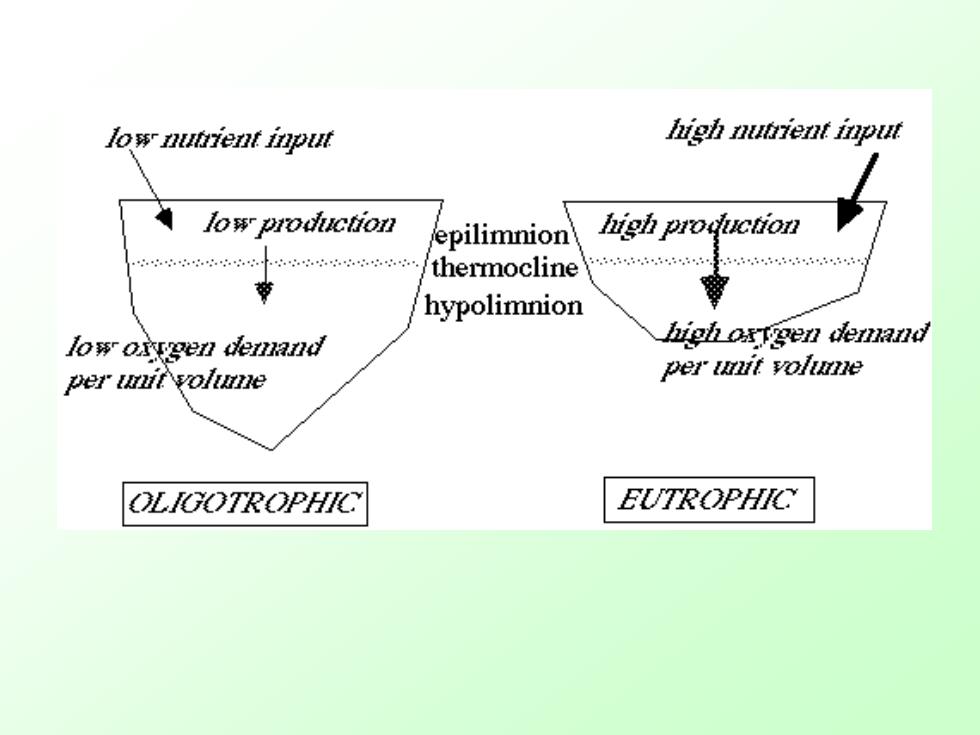
o"7地efpM ghhu地ent input low production epilimnion hgh proquction thermocline hypolimnion 0翔ro3边eand high oxroen demand per uit volume per uit volte L⑦TR⑦PH, ELTR⑦PH
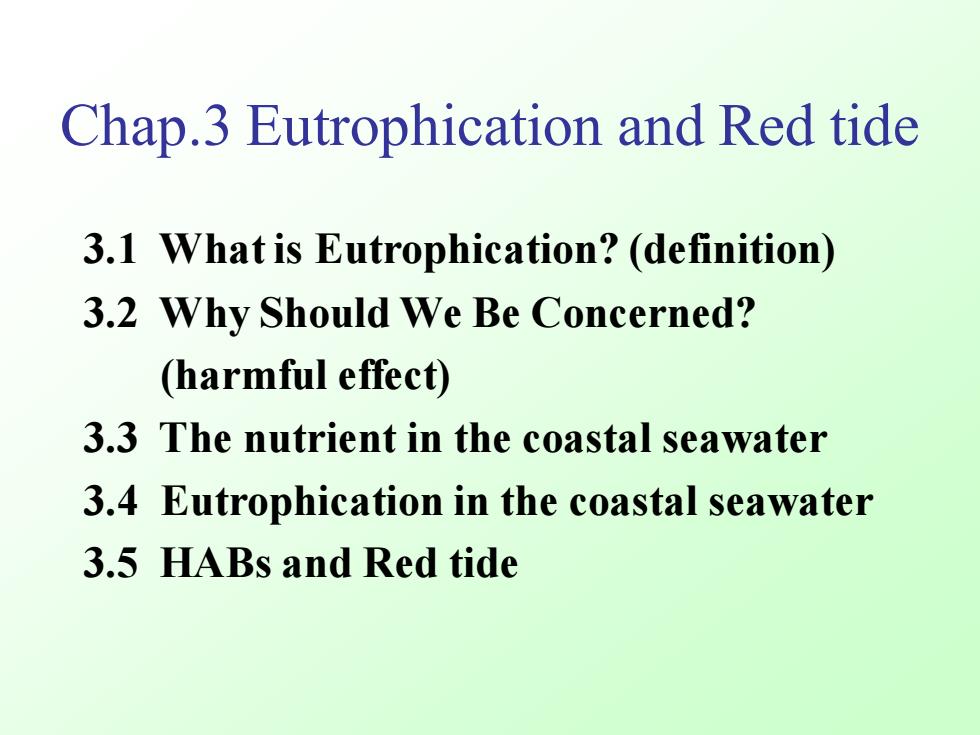
Chap.3 Eutrophication and Red tide 3.1 What is Eutrophication? (definition) 3.2 Why Should We Be Concerned? (harmful effect) 3.3 The nutrient in the coastal seawater 3.4 Eutrophication in the coastal seawater 3.5 HABs and Red tide
Chap.3 Eutrophication and Red tide 3.1 What is Eutrophication? (definition) 3.2 Why Should We Be Concerned? (harmful effect) 3.3 The nutrient in the coastal seawater 3.4 Eutrophication in the coastal seawater 3.5 HABs and Red tide
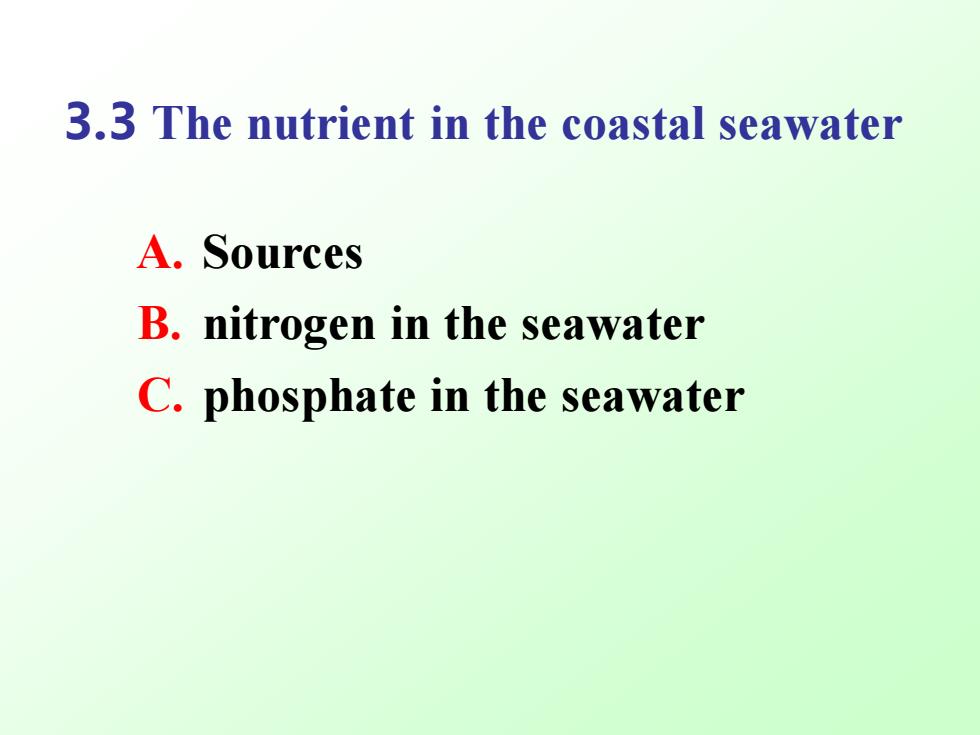
3.3 The nutrient in the coastal seawater A. Sources B. nitrogen in the seawater C. phosphate in the seawater
3.3 The nutrient in the coastal seawater A. Sources B. nitrogen in the seawater C. phosphate in the seawater

◼ The main addition of N and P compounds to the marine environment are considered to be sewage wastes, either directly discharged to the sea or via rivers into which treated waste are discharged. ◼ Other sources are agricultural runoff and wastes from food processing industries,but these are normally considered to be small compared to the input of sewage. 3.3 The nutrient in the coastal seawater
◼ The main addition of N and P compounds to the marine environment are considered to be sewage wastes, either directly discharged to the sea or via rivers into which treated waste are discharged. ◼ Other sources are agricultural runoff and wastes from food processing industries,but these are normally considered to be small compared to the input of sewage. 3.3 The nutrient in the coastal seawater